Advancements in TV technology have led to more seamless experiences, transforming how viewers watch content, stream entertainment and music, as well as consume social videos and gaming. Explore more on how these technological advancements are impacting the media landscape and evolving viewer experiences.
Ownership
Given their ability to aggregate lots of content sources in one place, Smart TVs are moving into position to own the home entertainment space with easy access to various types of digital media entertainment.
U.S. Consumers Favor Smart TVs Over External Streaming Devices
Recent data indicates a significant shift in U.S. television consumption habits, with consumers increasingly favoring smart TVs with integrated streaming capabilities over external streaming devices. (Samsung Ads Q1 & Advertising Research Foundation 2025 State of Video report)
Decline in External Streaming Devices
The adoption of external streaming devices connected to smart TVs has seen a significant decrease, indicating a shift towards integrated smart TV functionalities.
- In 2024, the number of external streaming devices connected to smart TVs in the U.S. declined by 31%.
- Roku’s connected devices decreased from 40.3 million in 2023 to 28.1 million in 2024.

Growth in Smart TV Adoption
Despite the decline in external devices, Smart TV adoption continues to grow, reflecting consumers’ preference for built-in streaming capabilities.
- Smart TVs are now present in 83% of the 122 million U.S. TV households.
- This equates to smart TVs being in 77% of the 133 million total U.S. households.
- There has been significant growth in ownership of Smart TVs in the market with U.S. Internet users with Q3 2024 ownership at 78%, versus just 59% in Q3 2016. (Ampere Analysis, 2025)
- In 2024, the average consumer uses 7 different sources of TV, not to mention 13 sources of digital entertainment (across TV, gaming, music, social video and more). (Hub “Evolution of the TV Set” Study, 2024)
- With an average of about 3 TV sets per household, most TV sets are now smart TVs (more than half – 1.7), which continues to grow each year. (Hub “Evolution of the TV Set” Study, 2024)

- In addition, two-thirds (67%) of Internet households own a smart TV. (Parks Associates, 2024)
- Almost half (46%) of Internet households own a streaming media player, using Roku (43%) and Amazon Fire TV stick/player most often (35%).
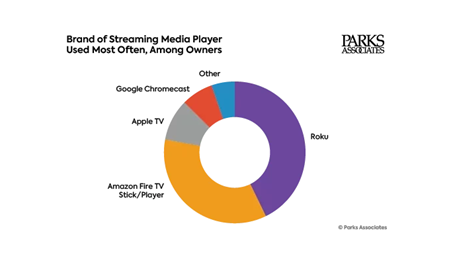
Usage
Trends in TV Viewing Habits
Patterns are shifting in how audiences consume television content.
- Time spent streaming increased by 5% year-over-year in Q4 2024.
- Traditional linear TV viewing time declined by 19% in the same period.
- Overall TV usage in the U.S. declined by 2% year-over-year, a notable change given the previous trend of increasing TV consumption during the pandemic era.
(Samsung Ads Q1 & Advertising Research Foundation 2025 State of Video report)
Subscription Streaming Services Churn
The report also indicates that churn rates for subscription streaming services remain high, based on Samsung’s automatic content recognition data.
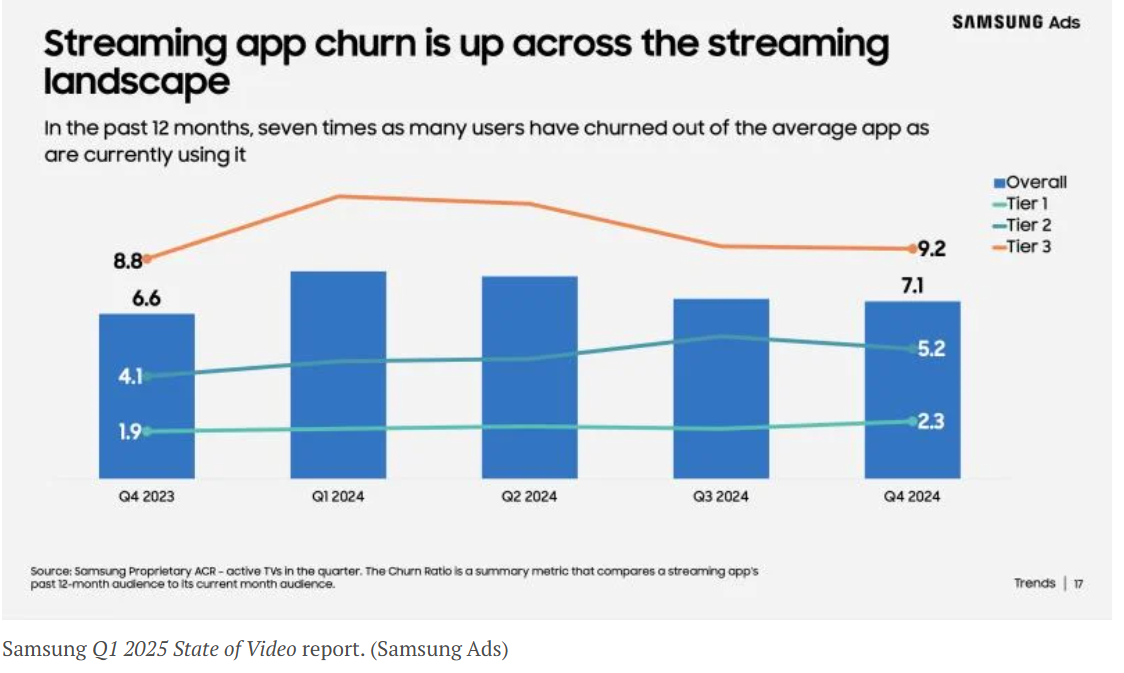
- CTV viewing levels are approaching the record levels seen during the pandemic and that the average viewing sessions are growing.

- Connected TVs account for over one-third of total TV usage. (StackAdapt, 2024)
- Among 18–64-year-old Internet users, Smart TVs are now the predominant device for consuming content in the U.S. with time spent watching content on Smart TVs increasing by 27% since Q1 2021. (Ampere Analysis, 2025)

- Almost one-third (31%) of viewing time among Internet users is via a Smart TV – higher than any other connected device. Among this group, Smart TV’s share of viewing overtook that of ‘regular’ TV in Q3 2022 and has been growing since. (Ampere Analysis, 2025)
- U.S. Internet users now spend more than 1hr 30mins daily watching content on Smart TVs. (Ampere Analysis, 2025)
- The number of CTV viewers in the U.S. will reach 233.9 million in 2024, with roughly 115.1 million households watching CTV. (eMarketer, 2024)
- Viewing on Smart TVs in the U.S. has increased most among 55-64-year-olds who increasingly engage with digital content. This cohort’s viewing of streaming services has increased by 61%, faster than any other age group. (Ampere Analysis, 2025)
- CTV usage among younger generations is increasing with forecasts of 62.6 million Millennials and 56.1 Gen Zers in the U.S. to watch CTV in 2025. (Statista, 2024)

- More than half (56%) consider their smart TV their primary device for consuming video (56%) compared to just over one-third (34%) primarily using external streaming devices. (Parks Associates, 2024)
- More smart TV owners are using nearly all the non-TV features from their TVs, with half (49%) of using their TV to stream music followed by using it to “mirror” / “cast” to the TV screen (38%) or check news, weather or traffic (24%). (Hub “Evolution of the TV Set” Study, 2024)
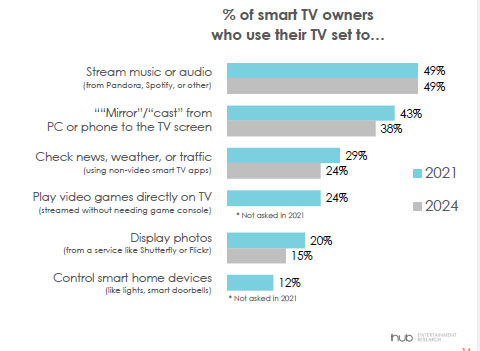
Apps and Search
- Two-thirds (65%) start their viewing from the home screen of a smart TV via apps (38%) or media player (27%) vs a pay-TV home screen (19%). (Hub “Evolution of the TV Set” Study, 2024)

- More than half (51%) of smart TV owners said they added suggested apps during the setup process. (Hub “Evolution of the TV Set” Study, 2024)
- When searching for shows on a smart TV, starting on a smart TV home screen or search function, bypassing individual apps (50%) is just as common as opening a specific app like Disney+ or Netflix (50%). (Hub “Evolution of the TV Set” Study, 2024)
Advertising
- CTV has become the fastest-growing ad channel in the U.S. accounting for 1 in 10 US dollars spent on digital advertising (90% of which is transacted programmatically). (StackAdapt)
- CTV is experiencing significant growth, with ad spending expected to increase by 18.8% this year, driven by the Olympics and elections. (Wurl, 2024)
- CTV advertising has increased by nearly 400% since 2019 and is projected to see double-digital ad spend growth in the U.S. through the end of 2027 and forecasted to surpass $42 billion by 2028. (eMarketer, 2024).
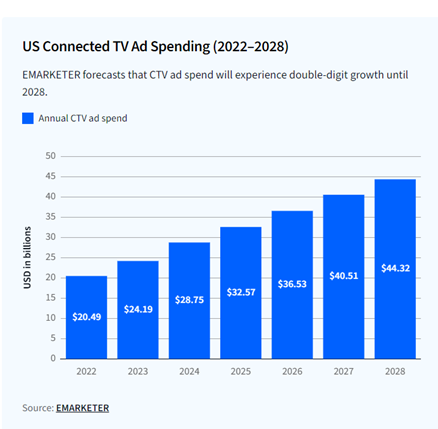
- CTV ad spending will account for 42% of total CTV and linear ad spend in 2027. (e-Marketer)
- One-third of U.S. viewers have used their CTV devices to complete a purchase after viewing an ad. (IAB, 2024)
- CTV ad attention increased to 51.5% in Q1’2024 (IAB, 2024)
- About seven-out-of-ten consumers (69%) say they won’t skip an ad if it’s for a product or service they’re already interested in. (Nielsen, 2024)
- CTV Measurement & Metrics (StackAdapt):

Resources
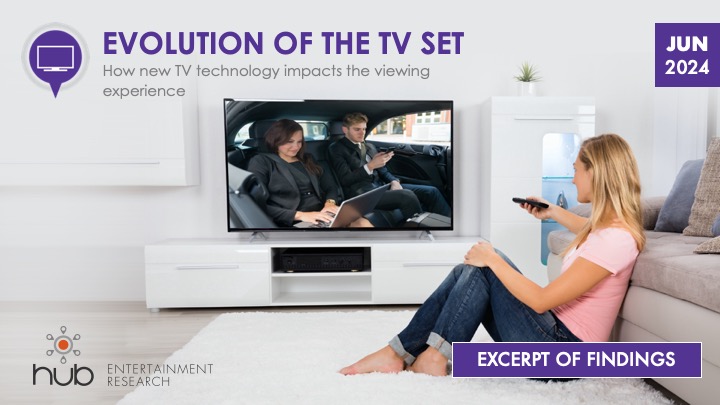
Evolution of the TV Set
Hub Entertainment Research, 2024
Streaming media players still have a strong presence in living rooms, but the ease of “all-in-one” Smart TVs positions them to gain dominance Discover how the strength of improved operating systems (OS) built into those TV sets are shaping viewing behavior around what and how people are watching.


